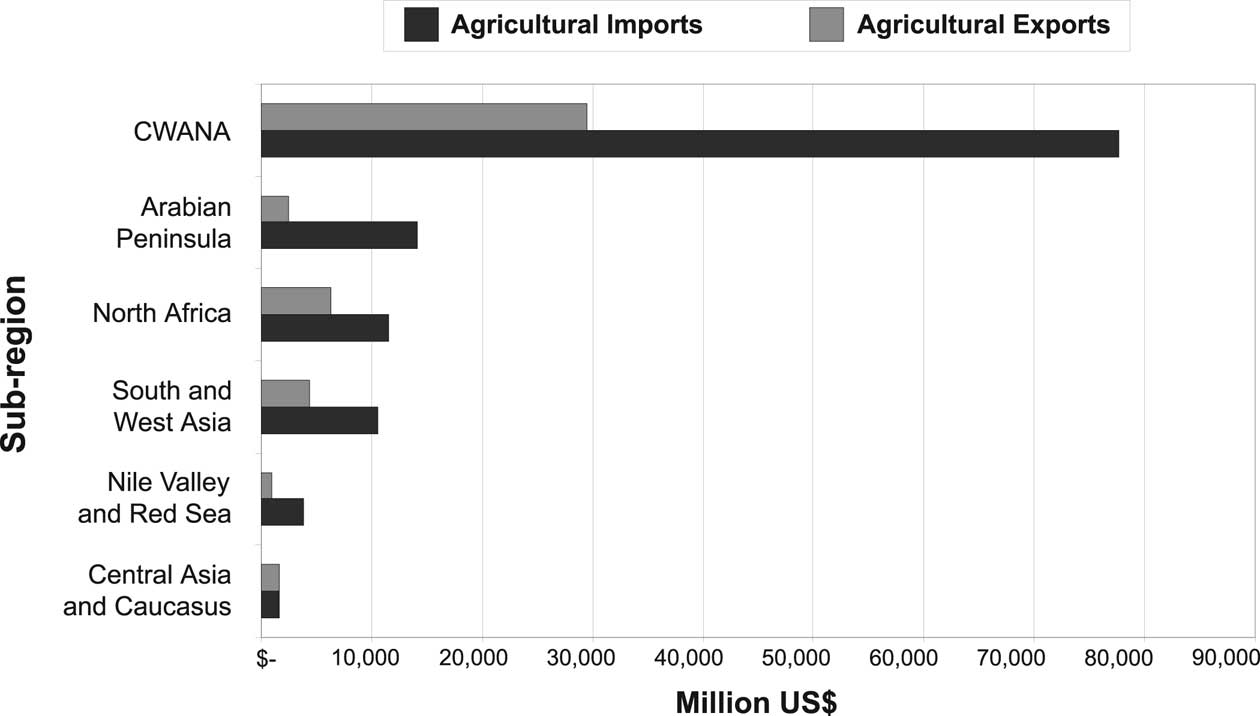
| Previous | Return to table of contents | Search Reports | Next |
| « Back to weltagrarbericht.de | ||
Historical and Current Perspectives of AKST | 35

Figure 2-2. Water resources per inhabitant in the CWANA region. Source: AQUASTAT, FAO database
|
water management and irrigation techniques, introduction of new techniques to regulate irrigation and encouragement of farmer associations to share and manage water. In Tunisia, drip irrigation is partly subsidized. In rainfed agriculture water-harvesting techniques help supply crops with water. In CWANA arid and semi-arid areas, more than one million hectares are managed to harvest water for agriculture, mainly in West Asia and North Africa. Several countries in North Africa, the Arabian Peninsula and the Nile Valley and Red Sea regions that have few renewable water resources overlie important nonrenewable fossil groundwater basins. These basins are partly shared with neighboring countries. For Algeria, Tunisia, Libya, Egypt, Saudi Arabia and the United Arab Emirates fossil water is an important resource. Libya exploits 3.7x109 m³ per year of its fossil groundwater. Although groundwater reservoirs may allow storage of huge quantities of water accumulated during the pluvial periods of the Quaternary, their development cannot be considered sustainable. The lack of recharge results in the slow depletion of the aquifers. Moreover, as the water level declines, it increases the cost of pumping, and the water quality deteriorates in some areas. This may make the extraction of fossil water less attractive. Urbanization, tourism and industry pushed authorities in some countries to undertake adequate measures to protect wastewater collection sites from likely medium- to long-term pollution. The creation of treatment plants and the adoption of policies to reuse treated wastewater have contributed to increases in wastewater produced and treated. Desalinated water is important in the Arabian Peninsula |
and Egypt. Saudi Arabia, the United Arab Emirates and Kuwait are, by far, the largest users of desalinated water. They use 71% of the total for CWANA, with Saudi Arabia alone accounting for 42%. Groundwater is a significant resource. Irrigated areas in CWANA are estimated at 30x106 ha, which is 7% of the agricultural area, using nearly 130x109 m3 of irrigation water per year. Roughly 13x109 m3 of irrigation water could be recuperated, monitored for quality and used. Many countries have sustained agricultural development in diverse regions and urbanization of neighboring zones has accelerated. Water transfers can be used to more equitably distribute water and reduce the gap between demand and supply by according priority to potable water needs and getting the most benefit from each unit of water. Internationally, the debate about water diversion has become heated. Many water-transfer projects have already been made in many CWANA countries. Resistance is growing to further developments, such as diverting water from water-abundant to water-scarce regions, even when the projects promote economic development, poverty alleviation and environmental protection. Examples of huge water-transfer projects are the Southeastern Anatolia Project in Turkey, the Nile River initiative and water management in the Jordan River region. The technical issues of these different water-management strategies are not the main problem. Environmental and social issues have become the main constraints. Taking turns among water users started about 1760 BCE in Palmyra with Hammurabi's Code. Water pricing was used in 137 CE (Sartre, 2001). Today water pricing is increasingly accepted as public policy throughout CWANA. |
| Previous | Return to table of contents | Search Reports | Next |
| « Back to weltagrarbericht.de | ||